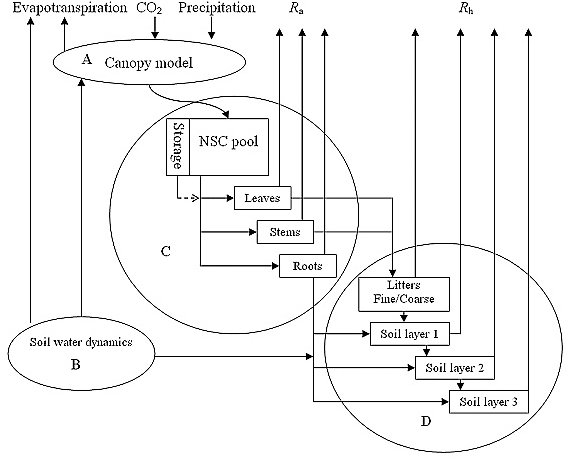Objective:
We are developing a new dryland version of the ecosystem model TECO (Weng & Luo 2008). This model assimilates SEV LTER data to constrains predictions on ecosystem responses to climate trends and variance. We use the TECO model to predict ecosystem dynamics into the future and explore parameter space beyond what we can manipulate. These efforts allow us to explore the responses of biogeochemical processes and biophysical feedbacks and predict ecosystem responses to climate variability following disturbances.
We intend to build a new front-end to TECO to link traits to ecosystem processes, increasing information on why are some ecosystems are more sensitive to climate mean and variance than others. By varying trait distributions in TECO simulations, we can evaluate how trait change alters ecosystem sensitivity to climate over long time periods. We have the distinct advantage of 10+ years of ongoing tower flux data from each SEV ecosystem type, which aid in both parameterization and validation of TECO.
Novelty:
Prior work has focused on predicting ecosystem processes responses to changing mean climate. Our SEV LTER program adds novelty by considering the mean × variance interaction, which is particularly relevant for drylands. Moreover, TECO will be first constrained by observations via data assimilation before used to predict ecosystem responses to changing mean and variance of precipitation.
Design:
TECO is a typical terrestrial ecosystem model that simulates biophysical and biogeochemical processes in ecosystems. TECO has five major components: (1) canopy photosynthesis, (2) soil water dynamics, (3) plant growth, (4) litter and soil C decomposition and transformation, and (5) N dynamics. Canopy photosynthesis is derived from a two-leaf (sunlit and shaded) model that simulates canopy conductance, photosynthesis, and partitioning of available energy. In the soil water dynamic submodel, soil is divided into 10 layers. Soil water content of these layers is determined by the mass balance between water influx and efflux. The plant growth submodel simulates carbon allocation and phenology. Allocation of the carbon among different plant components depends on their growth rates. Phenology is related to leaf onset, which is triggered by growing degree days, and leaf senescence, which is determined by temperature and soil moisture. The transfer submodel estimates carbon transferring from plants to litter and three soil layers. The nitrogen submodel is fully coupled with carbon processes with one additional mineral N pool. N is absorbed by plants from mineral soil and partitioned among leaf, woody tissues, and fine roots. N in plant detritus is transferred among different ecosystem pools (i.e. litter, fast, slow and passive SOM). The model is driven by climate data (including air and soil temperature, vapor-pressure deficit, relative humidity, incident photosynthetically active radiation, and precipitation) at hourly steps.

Soil hydrological properties regulate grassland ecosystem responses to multifactor global change: A modeling analysis.
Responses:
TECO has been used successfully to quantify the main and interactive effects of climate warming, altered precipitation, and elevated [CO2] on net primary production (NPP), heterotrophic respiration (Rh), net ecosystem production (NEP), transpiration, and runoff in a variety of ecosystems (e.g., Luo et al. 2008, Xu et al. 2015a). In addition, we have used TECO in model inter-comparison projects with a dozen other ecosystem models at 22 AmeriFlux sites and several CO2 experiments. Various datasets, including data streams for meteorological data, water table, phenology, and respiration, plus discrete measurements of C flux, above- and belowground biomass, and soil carbon content, have been assimilated through EcoPAD to constrain the TECO model. A distinct advantage of TECO is that it can be used effectively in a data assimilation (DA) framework. Luo and his group have used TECO with data assimilation in many other ecosystems and experiments.
In this project, TECO will be wrapped into EcoPAD to assimilate observations from the mean x variance experiment and forecast ecosystem responses to experimental treatments in a near-real-time fashion so as to advance our dryland research via timely interactions between experimenters and modelers.
